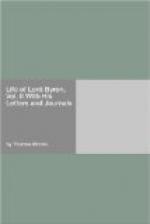But the longest, as well as most splendid, of those passages, with which the perusal of his own strains, during revision, inspired him, was that rich flow of eloquent feeling which follows the couplet,—“Thou, my Zuleika, share and bless my bark,” &c.—a strain of poetry, which, for energy and tenderness of thought, for music of versification, and selectness of diction, has, throughout the greater portion of it, but few rivals in either ancient or modern song. All this passage was sent, in successive scraps, to the printer,—correction following correction, and thought reinforced by thought. We have here, too, another example of that retouching process by which some of his most exquisite effects were attained. Every reader remembers the four beautiful lines—
“Or, since that hope
denied in worlds of strife,
Be thou the rainbow to the
storms of life!
The evening beam that smiles
the clouds away,
And tints to-morrow with prophetic
ray!”
In the first copy of this passage sent to the publisher, the last line was written thus—
{_an
airy_}
“And tints to-morrow
with a { fancied } ray”—
the following note being annexed:—“Mr. Murray,—Choose which of the two epithets, ‘fancied,’ or ‘airy,’ may be the best; or, if neither will do, tell me, and I will dream another.” The poet’s dream was, it must be owned, lucky,—“prophetic” being the word, of all others, for his purpose.[108]
I shall select but one more example, from the additions to this poem, as a proof that his eagerness and facility in producing, was sometimes almost equalled by his anxious care in correcting. In the long passage just referred to, the six lines beginning “Blest as the Muezzin’s strain,” &c., having been despatched to the printer too late for insertion, were, by his desire, added in an errata page; the first couplet, in its original form, being as follows:—
“Soft as the Mecca-Muezzin’s
strains invite
Him who hath journey’d
far to join the rite.”
In a few hours after, another scrap was sent off, containing the lines thus—
“Blest as the Muezzin’s
strain from Mecca’s dome,
Which welcomes Faith to view
her Prophet’s tomb”—
with the following note to Mr. Murray:—
“December 3. 1813.
“Look out in the
Encyclopedia, article Mecca, whether it is there
or at Medina
the Prophet is entombed. If at Medina, the first
lines of my alterration
must run—
“Blest
as the call which from Medina’s dome
Invites
Devotion to her Prophet’s tomb,” &c.
If at Mecca, the lines
may stand as before. Page 45. canto 2d,
Bride of Abydos.
Yours, B.
“You will find
this out either by article Mecca, Medina,
or
Mohammed.
I have no book of reference by me.”




